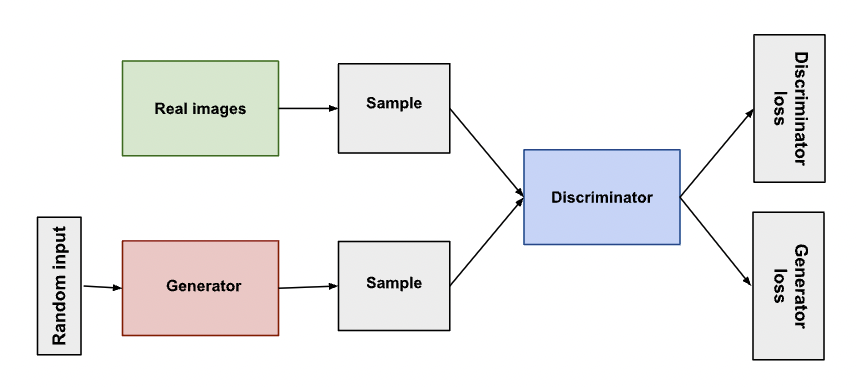
GAN stands for Generative Adversarial Network.
GANs are a type of neural network architecture where two networks compete with each other in order to generate new data that is similar to the training data.
GANs were first proposed in 2014 by Ian Goodfellow and his colleagues.
GANs have been used to generate ersatz images, deepfake videos, and even fake news articles.
GANs can be used for any type of data generation task.
Table of Contents
Types of generative adversarial networks (GAN) architectures
There are two types of GAN architectures:
1) The vanilla GAN architecture, which consists of two networks: a generator network and a discriminator network.
2) The conditional GAN architecture, which consists of three networks: a generator network, a discriminator network, and a conditioning network.
The vanilla GAN architecture is the simplest GAN architecture and it is the one that we will be using in this tutorial.
The generator network
The generator network is responsible for generating new data.
The generator takes in a random noise vector as input and generates new data that is similar to the training data.
The discriminator network
The discriminator network is responsible for distinguishing between real data and fake data.
The discriminator takes in both real data and fake data as input and tries to learn to distinguish between them.
Training a GAN
To train a GAN, we need to first define a loss function. The loss function tells us how well the GAN is performing.
There are two types of loss functions that can be used:
1) The GAN loss function, which is used to train the generator network.
2) The GLS loss function, which is used to train the discriminator network.
The GAN loss function is defined as follows:
LGAN(G,D)=−Ex∼pdata(x)[logD(x)]−Ez∼pz(z)[log(1−D(G(z)))]
The GLS loss function is defined as follows:
LGLS(G,D)=Ez∼pz(z)[logD(G(z))]+(1−λ)Ex∼pdata(x)[log(1−D(x))]
where λ is a hyperparameter that controls the trade-off between the GAN loss function and the GLS loss function.
The GAN loss function is used to train the generator network and the GLS loss function is used to train the discriminator network.
Generative models
A generative model is a model that can generate new data. GANs are a type of generative model.
Other types of generative models include:
1) Autoencoders
2) Variational autoencoders (VAEs)
3) Generative stochastic networks (GSNs)
4) Restricted Boltzmann machines (RBMs)
5) Deep Boltzmann machines (DBMs)
6) Denoising autoencoders (DAEs)
7) Adversarial autoencoders (AAEs)
8) Gated recurrent units (GRUs)
9) Long short-term memory (LSTM) networks
10) Variational LSTM (VLSTM)
11) Generative adversarial networks (GANs)
12) Energy-based GANs (EBGANs)
13) Adversarial GANs (AGANs)
14) Cycle GANs (CGANs)
15) Dual GANs (DGANs)
16) Star GANs (SGANs)
17) Info GANs (IGANs)
18) Wasserstein GANs (WGANs)
19) Least squares GANs (LSGANs)
20) Conditional GANs (CGANs, info GAN variant)
Variational autoencoders are the most popular type of generative model.
GANs are the second most popular type of generative model.
A Friendly Introduction to Generative Adversarial Networks (GANs)
GAN machine learning applications
GANs are a type of machine learning and deep learning and can be used for any type of data generation task.
GANs have been used to generate images, fake videos, and even fake news articles.
GANs can also be used for data augmentation and data visualization, which is a technique used to improve the performance of machine learning models.
Data augmentation is a technique used to improve the performance of machine learning models by increasing the amount of training data.
GANs can be used to generate new data that can be used to train machine learning models.
GANs have also been used to generate realistic 3D images of objects. GANs can also be used to create 3D models from 2D images.
GAN neural network
A GAN neural network is a type of neural network that is used to train GANs. GANs are training using a GAN neural network.
The GAN neural network consists of two networks: the generator network and the discriminator network.
The generator network is responsible for generating new data. The discriminator network is responsible for distinguishing between real data and fake data.
GAN – FAQs
What is a GAN?
A GAN is a type of neural network architecture where two networks compete with each other in order to generate new data that is similar to the training data.
GANs were first proposed in 2014 by Ian Goodfellow and his colleagues.
GANs can be used for any type of data generation task.
What are Gans (Generative Adversarial Networks)?
How do GANs work?
GANs work by training two networks, a generator network and a discriminator network, against each other.
The generator network generates new data, while the discriminator network tries to distinguish between real data and fake data.
The two networks are trained using a GAN loss function.
What are the benefits of GANs?
GANs have many benefits, including:
1) GANs can be used for any type of data generation task.
2) GANs can generate realistic data.
3) GANs can be used to improve the performance of machine learning models.
4) GANs can be used to create 3D models from 2D images.
5) GANs can be used to generate new data for training machine learning models.
What are some applications of GANs?
Some applications of GANs include: image generation, video generation, 3D object generation, and data augmentation.
GANs have also been used to generate written or visual content.
Summary – Generative Adversarial Network (GAN)
A GAN is a type of neural network architecture where two networks compete with each other in order to generate new data that is similar to the training data.
GANs were first proposed in 2014 by Ian Goodfellow and his colleagues.
GANs have been used to generate fake images, fake videos, and even fake news articles.
GANs can be used for any type of data generation task. GANs work by training two networks, a generator network and a discriminator network, against each other.
The generator network generates new data, while the discriminator network tries to distinguish between real data and fake data. The two networks are trained using a GAN loss function.
Some benefits of GANs include that GANs can be used for any type of data generation task, GANs can generate realistic data, GANs can be used to improve the performance of machine learning models, GANs can be used to create 3D models from 2D images, and GANs can be used to generate new data for training machine learning models.
Some applications of GANS include image generation, video generation, 3D object generation, and data augmentation.


![Backwards 3: How to Type "Ɛ" [EASY]](https://softwareblade.com/wp-content/uploads/2022/02/Screen-Shot-2022-02-19-at-9.03.25-PM-150x150.png)